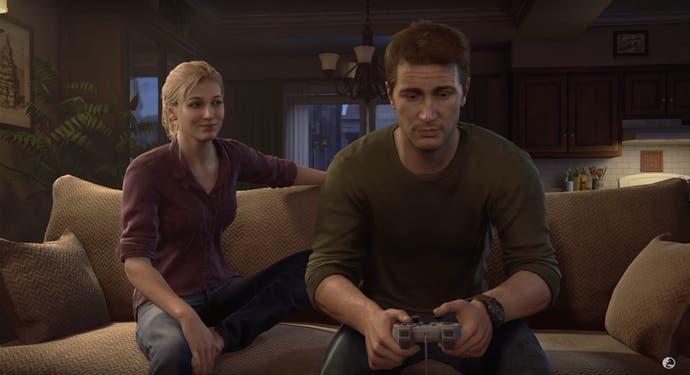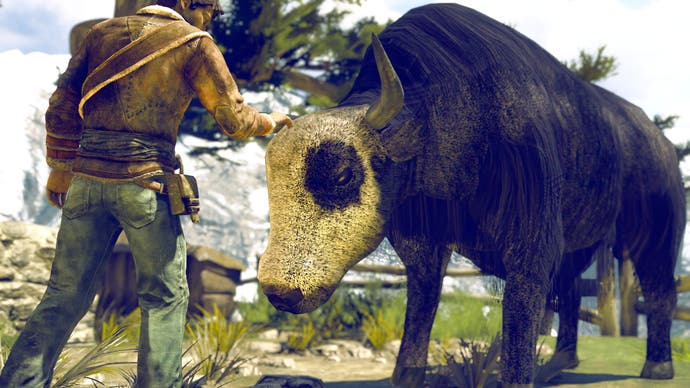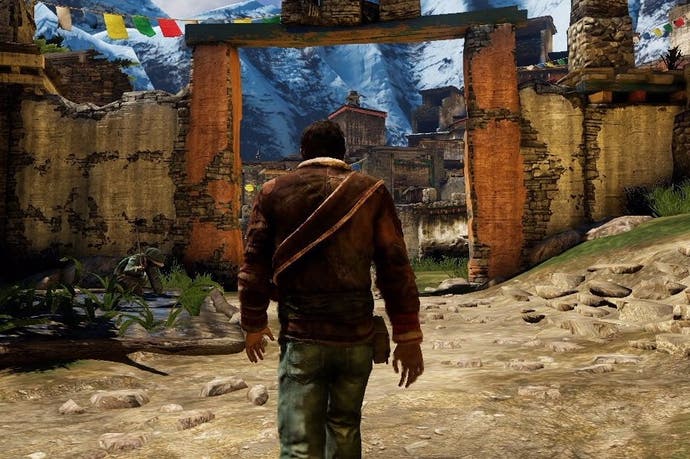Combat fatigues: How Uncharted is a walking simulator in action game's clothing
An old dog teaches new tricks.
On paper Naughty Dog's Uncharted series is as generic as it gets. It's about a good looking white, heterosexual man going on exciting globe-trotting adventures, killing bad guys and wooing a spunky blonde reporter. On this level, it's functional at best and banal at worst. But dig deeper and it becomes clear that Naughty Dog's bombastic blockbuster series quietly had a profound effect on the medium's development over the past several years.
The first Uncharted wasn't particularly revolutionary, though it did feature some snappy dialogue and stunning visuals for its day. It was really 2009's Uncharted 2: Among Thieves where Naughty Dog really went off the rails (literally in the case of its seminal train sequence) and managed to subtly provide a proof of concept for a type of video game that was still in its embryonic stage. The genre has since come to be labelled somewhat derisively as "walking simulators" - a video game with precious little interactivity and no game-over state.
Of course The Uncharted games do have a failure state and you spend most of their running time engaged in third-person combat. On that level, they're still fairly traditional action games. But Uncharted 2 and its successors only dedicate a little over half of their running time to such mechanics. So what do you do the rest of the time?
Not a lot, interactively. Sometimes you simply watch cutscenes and have zero input whatsoever. The rest of the time you're being funnelled through intentionally frictionless scripted puzzles or button-tapping your way through automated platforming sequences. Technically you're still "playing" the game, but your agency is left out of your hands.

And yet, no one seemed to mind. Part of this is because it looks exciting. Naughty Dog's penchant for slick action choreography is so captivating the player doesn't even notice that they barely have any input on what's happening (if they have any at all). But on a purely mechanical level, leading Drake up through a boxcar dangling off a cliff is no more interactive than selecting Henry's potentially flirtatious dialogue in Firewatch or guiding Kaitlin Greenbriar through her family's new abode in Gone Home.
Yet it's not just the choreography that made such sequences work. In truth, everything needs to work in order for action/adventure junkies - the core audience for the game - to be engaged. The characters need to be charismatic, the dialogue needs to be clever and well acted, the art direction and choreography need to be appealing, and the animations need to be emotive. If anything here fails, the whole enterprise suffers for it.
And, quite frankly, that's usually the case for downtime in action games. I shudder to think of how many times I've encountered a banal narrative-heavy sequence in a game where no one actually gives a toss about that side of the equation. Can you imagine if Halo or Doom spent approximately 40 per cent of their running time trying to tell a story or mixing up their core mechanics with lightweight platforming or puzzle elements? Chances are it wouldn't be good.
Yet Naughty Dog went for it. And what a risk that was! This was before Journey and The Stanley Parable had proved to the world that these sort of mechanics-lite deviations had market value, mind you. If people had found Uncharted 2's non-shooty bits boring it would have destroyed their enthusiasm for the game. Critics and players alike could have hated it. It could have killed the franchise. Maybe even ruined Naughty Dog.

Uncharted 2 designer Richard Lemarchand said at an IndieCade talk in 2011 that many at Naughty Dog were worried about the lengthy non-violent village interlude midway through the title - in which our wounded hero kicks soccer balls, shakes hands, and pets yak butts rather than shoots, runs or sneaks his way through a dangerous situation. But Lemarchand said he'd recently played Tale or Tales' 2008 offering The Graveyard, in which players control and elderly woman slowly walking through a graveyard.
"I thought that in the same way that The Graveyard had created a space for me where I could reflect, so could our village," the designer said at the time. It was a peculiar notion, at the time, to want to merge the ponderous pace of minimally interactive mood piece with the white knuckle bluster of a Hollywood action flick, but there you have it.
Then again, in a weird way it was the Uncharted series' conservative qualities that allowed Naughty Dog to sneak in its more avant-garde experiments. It's a bit like how Mad Max: Fury Road quietly implemented a strong feminist message in what looked like - and otherwise is - a lightweight action flick about a couple of good looking movie stars kicking ass in cool cars. (The film became known for its gender politics after the fact, but it wasn't promoted this way.) By making Uncharted such an old-fashioned matinee throwback with populist shooter elements, Naughty Dog, and publisher Sony, were better equipped to take a few chances.
Of course, what was revolutionary for 2009 isn't so groundbreaking now. Uncharted 4 pulls all the same tricks with even greater craftsmanship. In many ways it's gone even further in this experimental direction with roughly only a third of its opening eight hours dedicated to anything that could even remotely resemble an action game (though its first few minutes are appropriately rousing). And yet it's never boring. The jokes land. The story beats are appropriately moving. The dialogue sings. And it all looks glorious thanks to some of the best art direction and tech wizardry in the business.
In a world that's already seen the likes of Everybody's Gone to the Rapture, 30 Flights of Loving and Dear Esther, such bold pacing practices aren't quite as shocking as they were back in 2009. Yet Uncharted 4, for all its bombast, often feels more akin to those games than any of its big budget contemporaries. And maybe the widespread popularity of more sedate games can be in some part attributed to the brilliant Uncharted 2 - a game that proved blockbusters could be played at a very different tempo.










